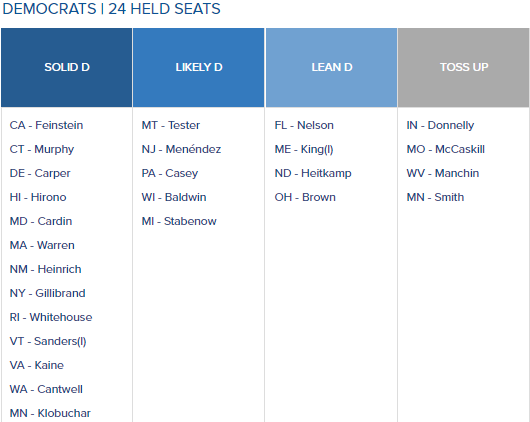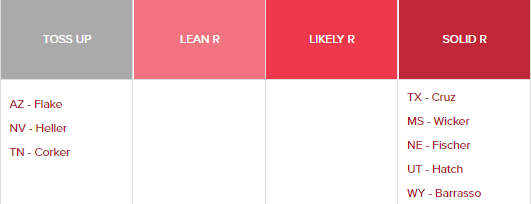Last week, when I painted the House, I discovered that despite the strength of Democrats on overrated “generic ballots,” they still had an uphill climb to obtain the majority in the House of Representatives (even if a record number of Republican House members are retiring). If Democrats’ quest to regain the House ultimately fails, that puts even more pressure on the flailing party to regain the other half of Congress. Are their chances any better in the upper chamber? Let’s find out.
The Senate
Current composition:

- Republicans: 51
- Democrats: 47
- Independents: 2 (both caucus with Democrats, effectively giving them 49)
- Wrinkle: Vice-President Pence can serve as a tie-breaking vote, as he has done on many occasions.
- Therefore, Democrats need to hit 51 for the true majority.
- Republicans would be satisfied with just 50.
- Number of seats Democrats need to ADD for a majority: 2
- Number of seats Republicans can LOSE to retain majority: 1
- Direct implications of having a majority — if a majority party votes together, it can:
- pick the Senate Majority leader.
- have a majority on conference committees, which bring bills to the Senate floor,
- control Senate bills and votes,
- block all House bills,
- have the power to advise and consent on the President’s major appointments, including the Supreme Court
At first glance, the GOP’s advantage in the House was much stronger and looked like it could withstand the Democratic advantage in national polling and the sluggish approval rating for President Trump. Meanwhile, in the Senate, we see there is almost no margin for Republican error. At 51-49, surely this strong Democratic wave is enough to swing them the majority, right?
Wrong.
Here’s why Republicans can breathe easier: math. In the House, all 435 seats are up for re-election this November. That means a strong Democratic wave can win dozens of seats across the country.
In the Senate, however, only about one-third of the seats are up for grabs; this year it’s 34 (the scheduled 33 plus a special election for Al Franken’s seat in Minnesota). The problem for Democrats, however, is that of those 34 seats, 26 are currently Democratic (24 plus the two Independent left-leaners) and only 8 are Republican. That means the Democrats have a lot of defense to play. For every seat they try to take from Republican hands, they need to defend three of their own.
To illustrate how difficult a situation this puts the Democrats in, let’s run a scenario. Let’s say each party keeps 75 percent of its seats. That means Democrats successfully win 2 of the 8 Republican spots — but the Democrats would also lose 8 of their own. The result would be the Republicans increasing their seat total from 51 to 57, and that was with each party retaining the same exact percentage of their seats up for re-election.
The goal for the Democrats, then, is almost impossible: find a way to win a couple Republican seats without losing ANY of their 26. If, for example, Democrats were to lose just 3 of their 26 (a rather successful 88.5 percent retention), they’d have to find a way to win most (5) of the 8 Republican-held seats, which we’ll see is a near impossibility.
In addition to the arithmetic, Republicans can also take heart in the advantageous battle lines themselves; Democratic Senators are up for re-election in ten states won by President Trump, but Republicans only need to defend one seat in a state won by Hillary Clinton.
Thus, while the House is an uphill climb for Democrats, it’s still a molehill compared to the Democrats’ Everest in the Senate, where math and geography conspire to keep them out of power. To determine, ten months out, their least treacherous path up the mountain, we need to take a closer look at individual races.
Like with the House, a good first step is the Cook Report, which categorizes the various Senate race. The initial breakdown is as positive as a Democrat could hope for:

As of now, none of their 26 seats are so much as leaning Republican. Meanwhile, Democrats can bank on holding 13 of their 26 without much of a fight, while five more look nearly as strong. Of the remaining eight, half are looking good, while half are toss-ups. It’s those four on the far right that Democrats need to be most worried about losing.
As for the Republican held eight:

Democrats have almost no shot in five Republican-held 2018 seats, which severely contracts the playing field. It also simplifies our calculations:
- Remember, it’s currently 51-49 in favor of the Republicans.
- If we take away the eight Republicans, their number drops to to 43. If we add back in the five solid Republican seats, they’re already back to 48.
- Their goal is just 50, so they need to find two more.
- Assuming no shifts in categorization, there are seven “toss-up” seats in 2018 Senate election (the 4 held by Democrats, and the 3 by Republicans).
- Republicans need to win two of those seven seats.
- Democrats need to win six of those seven seats.
Now you know the Senate races to follow. Keep an eye on:
- Democratic seats in Indiana, Missouri, West Virginia, and Minnesota.
- And Republican seats in Arizona, Nevada, and Tennessee.
Throughout 2018, we’ll check in on those seven races.
[…] election season. You are looking to frame the 2020 election while we just barely started on the 2018 midterms. Do we like polling? Always! Do we gobble it up? Ravenously. Is it like catnip for political […]
LikeLike
[…] winning re-election (slightly less than 50/50), but we’ll at least want to get through the midterms first. For the purpose of this post, however, let’s keep in mind that although the President […]
LikeLike
[…] been four months since my first 2018 midterms analysis. Now, just a half-year from our next set of major federal elections, it feels like a good time to […]
LikeLike
[…] Ten months out Six months out […]
LikeLike
[…] I’ve said in each of the last two Senate previews, those last two bullets almost impossibly blockade the Democratic Party’s […]
LikeLike
[…] normally start with the House in my Midterm breakdowns (here they are from ten months out, six months out, and two months out), but I want to give the House races another week to evolve. […]
LikeLike
[…] Months Out Six Months Out Two Months Out October 1 (Senate) Four Weeks Out […]
LikeLike
[…] written about the 2018 Senate elections throughout the year. In all that time — from January 15 through last week — I’ve consistently reminded you that this year’s combination […]
LikeLike